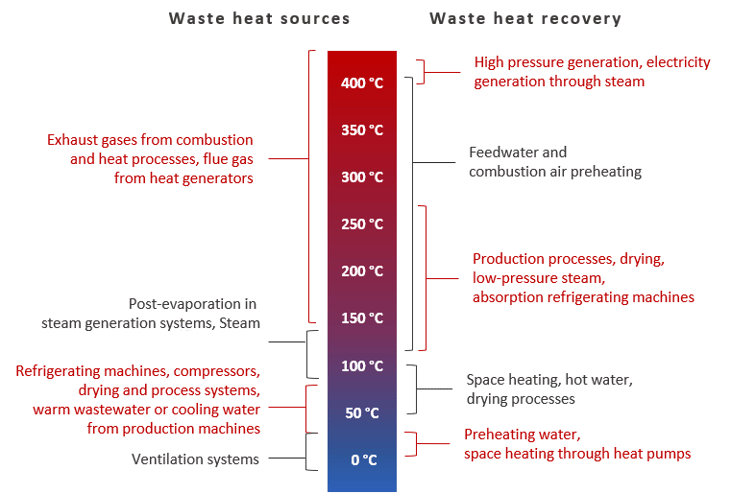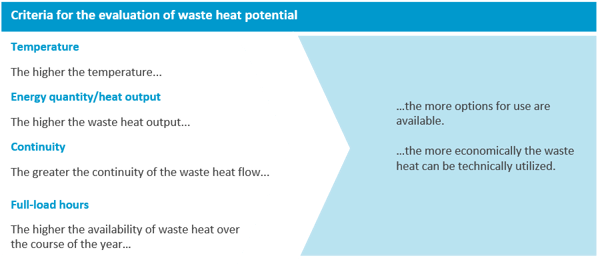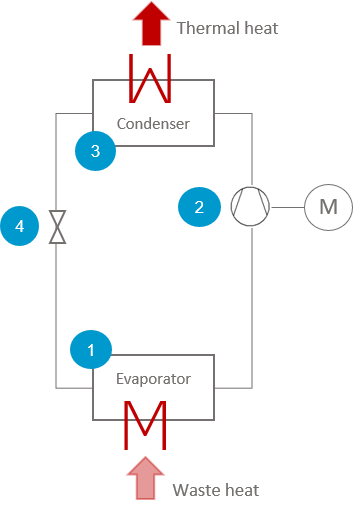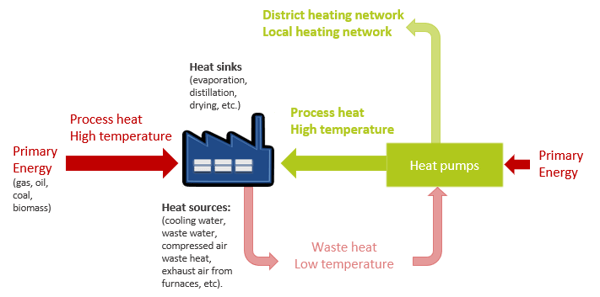The pulp industry is one of the most energy-intensive industrial sectors. A significant proportion of the energy used has been largely discarded as unused waste heat via exhaust air or wastewater. This heat can be used in an economically viable way to improve energy use and therefore reduce energy costs.
What to do with excess heat?
There are three options for the utilization of surplus thermal energy:
- Internal-process waste heat utilization: The waste heat is reintegrated into the same process (e.g. waste heat from the flue gas of a furnace is used to preheat the combustion air)
- In-house waste heat utilization: The waste heat is fed to an in-plant
consumer and reused in another process. It is also possible to use the waste heat to heat the plant buildings and heat water. Suppose waste heat is below the required energy level. It may be economical under certain conditions to use heat pumps to generate higher-temperature process heat from lower-temperature waste heat. - External waste heat utilization: The waste heat is extracted and fed into
an external district heating or local heating network if there is no internal
plant utilization option. At present, external heat utilization is still rarely
implemented, but it will become increasingly important in the future.
Efficient utilization of waste heat through cascade utilization
Excess heat at higher temperatures is frequently used in industrial processes in a cascaded manner. The waste heat passes through several phases connected in series with a decreasing temperature level to utilize the waste heat as efficiently as possible.
Example: Cascade utilization in a pulp mill
The waste heat is initially used to generate high-pressure steam or supplied to consumers that require high temperatures. Furthermore, this, in turn, creates waste heat but at a lower temperature level. Such waste heat is available as additional waste heat potential, which can be used, for example, to heat products, as feed water, or as boiler water.
What remains is waste heat at low temperatures below 100 degrees celsius, for which there are often no internal consumers. Instead of disposing of this energy, the best option is to transfer it to a district or local heating network, which usually operates at specific temperatures of 70 to 100 degrees celsius.

How are waste heat sources evaluated?
The production process in the pulp and paper industry involves numerous sequential production steps that take place at specific pressure and temperature conditions. Consequently, excess heat energy is generated whenever lower temperatures are required in a process step than in the upstream process step. For efficient use of such waste heat, the potential of existing waste heat sources must be pinpointed and matched with existing waste heat reduction.
1. Identifying the potential of waste heat sources
The following parameters define the potential level of waste heat sources:
- The temperature level of the waste heat source (the higher the temperature, the higher the value of the heat., the lower the temperature, the harder it is to find a customer).
- Heat quantity or thermal power available in the waste heat medium (maximum and average power).
- Medium of waste heat (specific heat capacity and composition)
- Time availability (continuous or fluctuating, seasonal, number of full load hours per year).
Safety and material requirements of the waste heat medium (e.g. toxic or flammable substances, aggressive or corrosive components).
When assessing the potential for heat recovery in pulp mills two main prerequisites are important: firstly, sufficient residual heat must be available at the highest possible temperatures, and secondly, there must be consumers who can "utilize" the surplus heat.
In summary, the criteria for evaluating waste heat potential can be presented as follows:

2. Adjustment of waste heat source and waste heat reduction
The prerequisite for the economic implementation of heat recovery systems is the conformity of the waste heat source and the heat consumer. The most important criteria in this regard are:
- Temperatures of waste heat and heat requirements: Since energy only ever flows from the warmer to the colder medium, the temperature of the waste heat should be higher than the temperature of the medium to be heated, as a general rule, the higher the temperature difference between the heat source and the heat sink, the more compact the design of the heat exchanger.
- Heat quantity and heat output: Furthermore, the heat quantity or output of the heat source should be greater than the demand of the heat sink. Otherwise, an additional heat generator may have to cover the peak load.
- Time sequence of waste heat production and heat demand: The better the match and time sequence of the heat source and heat sink , the greater the utilization of the heat source. The availability of waste heat should therefore correspond as closely as possible to the demand profile of the waste heat sink. Heat storage systems can be used if there is a time lag between heat availability and heat consumption.

In-house waste heat utilization
Suppose waste heat is used internally in a process or plant. In that case, this is done either directly via a heat exchanger or indirectly by feeding it into a plant-internal steam network. If certain conditions are met, then heat pump technology is also an option.
1. Waste heat utilization via heat exchanger
The utilization of waste heat through heat exchangers is usually the simplest and most cost-effective option from a technical point of view. A heat exchanger is worth considering in almost all cases where unused heat energy is produced as a "waste product" in order to increase the efficiency of the overall plant.
Heat exchangers make waste heat usable for processes at a similar or lower temperature level. They transfer the thermal energy of a medium (gas or liquid) to a medium of lower temperature without the two media touching or mixing. For this purpose, the warmer medium transfers its energy to the colder medium via the heat exchanger surface, which largely determines the performance of the apparatus.
Heat exchanger design criteria
Choosing the appropriate heat transfer technology depends on a variety of factors:
- State of aggregation of the waste heat and process medium (liquid/liquid, gaseous/liquid, gaseous/gaseous)
- Phase transition (evaporation or condensation of one or both media)
- Pressure level and pressure difference between the media
- Contaminated media require designs that are less susceptible to contamination and easy to clean.
- Corrosive, aggressive or hazardous media may require specific materials or special designs.
2. Feeding into the plant's internal steam network
Large mills in the pulp industry supply a wide variety of consumers via complex steam networks. For example, suppose sufficient waste heat with a temperature of well over 150 degrees celsius is generated at one point in the process. In that case, installing a steam generator to feed the waste heat into the mill energy network is an obvious solution. Most plants already use internal cycle closure to reduce the use of primary steam. As a result, almost all waste heat with a temperature level of over 140 °C is reused internally.
3. Heat utilization using industrial heat pumps
Heat pumps represent an efficiency-enhancing technology that will gain significant importance in the coming years. Their application can significantly reduce the use of fossil energy sources to provide process heat by boosting process waste heat to usable temperature levels and thus enabling it to be fed back into the processes (e.g., as process steam).
Focus is on low temperature waste heat
Low-temperature streams that cannot be used directly in heat exchangers are particularly relevant for waste heat utilization by heat pumps. Potential areas for their use in the pulp and paper industry are mainly washing and drying processes and evaporation and distillation. Low-temperature waste heat can also be fed into a local or district heating network as an alternative.
Mechanical vapor recompression in the pulp industry
Mechanical vapor recompressors are primarily used in the pulp industry as they are considered superior to other types of heat pumps in terms of efficiency and economy. Vapor compressors are open heat pump systems that do not have a refrigerant circuit. Instead, the gaseous waste heat medium is drawn in by a compressor and raised directly to a higher temperature level by increasing the pressure. The field of application covers all thermal separation processes.
For chemical recovery in both the sulfite and sulfate processes, the technology is used to raise the process steam (vapor) generated during caustic evaporation to a higher temperature and thus higher energy level and then fed back into the process as working steam. The energy required to create live steam is considerably higher by comparison. Mechanical vapor recompression has proved particularly successful for projects which increases the existing plants' performance and pre-evaporation.

External use: From waste heat to local and district heating
If no suitable users are found within the pulp mill, waste heat can be sold to third parties via low-temperature heat networks rather than being destroyed. Another option is to take over peak loads in district heating networks, mainly where plant operators handle their own energy supply.
Decoupling to heat networks offers high flexibility
Local and district heating networks have the advantage of using a large number of different heat sources flexibly, which can be both centralized and decentralized. In addition, the heat network takes in different energy sources at different levels and points, regardless of summer or winter.
So whatever waste heat is generated and is economically viable in the pulp mill can be extracted and profitably fed into the heating network. As a result, the company saves cooling water costs, generates income from the sale of heat energy, and also makes an essential contribution to reducing CO2 emissions, as the heat fed in would otherwise have to be generated elsewhere.
Complexity requires comprehensive potential analysis
The majority of pulp mills in Europe have grown historically and expanded over time. Consequently, each mill is unique with its specifics, operating points, and feeds. In addition, energy use is very complex, and specific energy consumption varies widely among pulp mills. Therefore, each plant must be analyzed comprehensively to evaluate the waste heat potential. Then, once it has been cleared which energy surpluses need to be extracted on the process side, the heat exchangers can be optimized according to the boundary parameters.
Large heat pumps as a promising technology for the future
Pulp processes frequently generate waste heat below the 50 to 70 degree celsius temperature spectrum and are therefore not suitable for low-temperature district heating networks. In the coming years, large heat pumps will become increasingly common for utilizing such energy sources.
Large heat pumps are a cost-effective way of integrating previously unused waste heat into internal processes as well as local and district heating networks. They extract thermal energy from waste heat sources at a comparatively low-temperature level and make it available to the local or community heating network at a higher temperature level.
Open systems similar to vapor recompression or closed systems with an auxiliary medium are used. However, even waste heat below 50 degrees celsius still offers a considerable temperature level and can be raised to a low-pressure steam level with heat pumps based on a multistage compressor system at a reasonable cost.
Heat pumps are technologically advanced and operate reliably, efficiently, and economically. Today, the most significant challenge no longer lies in the heat pump technology but in the optimal design and integration of the heat pump into the overall system.
Maximum efficiency with compression heat pumps
Electrically driven compression heat pumps are crucial in local and district heat extraction as efficient heat transformers. In contrast to vapor compressors with an open circuit, compression heat pumps have a closed system that operates according to the cold vapor principle and is driven by a mechanical compressor:
- The heat exchanger (evaporator): By adding waste heat, the auxiliary medium (refrigerant) is evaporated due to the low boiling temperature.
- Compressor: The refrigerant in the compressor is brought to a condensing
pressure and temperature. - Condenser/liquefier: The auxiliary medium releases the heat via a heat
exchanger and condenses in the condenser. - Expansion valve: The condensate is decompressed, causing the auxiliary medium to liquefy completely again and the temperature to drop below the level of the waste heat. This allows heat transfer from the waste heat to the refrigerant.

Conclusion: Industrial waste heat utilization in the pulp industry
In addition to measures taken to reduce energy consumption, waste heat utilization is one of the company's most profitable ways of minimizing energy consumption through the appropriate plant technology. In particular, vapor recompression and large-scale heat pumps are becoming increasingly important and, together with energy extraction in local and district heating networks, will be increasingly used in the coming years.
In the pulp industry, GIG Karasek has a high level of expertise in analyzing and evaluating waste heat flows and their potential utilization. In addition, we have many years of experience in integrating heat recovery systems in pulp mills and manufacturing the necessary equipment.






